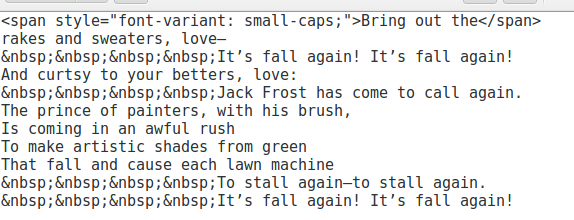[An update: WordPress now includes a “Verse” block that makes it possible to format poetry visually. It took many years, but it finally happened. The block is much more simpleminded than what Dr. Boli proposed in this article, but it does at least preserve spacing used as indentation.]
You can tell the Internet was invented after the death of poetry, because HTML, the engine that formats the World-Wide Web, has no way of dealing with even the most elementary poetic form—such as, for example, a ballad.
Here is a stanza from a ballad by Thackeray:
It is perfectly simple; there is not a simpler poetic form. But how would one achieve those simple and obvious indentations in HTML?
One might add spaces at the beginnings of lines. But it won’t work, because, like most of the Internet, one uses WordPress. And WordPress will look at a series of spaces at the beginning of a line and panic. “How did those get there?” it will say. “I’ll get rid of them at once, before anybody notices.”
You may recall that, two days ago, Dr. Boli published a little poem whose form was not especially complex, but nevertheless required indenting some of the lines. The only practical way to do that is by adding codes for nonbreaking spaces.
Here is how the poem looked while it was being set in WordPress type.
 That, you will agree, is very cumbersome; but we have not come to the worst part. Here is the worst part: that article is uneditable. If one needs to change as much as a single comma, one will lose all the formatting, because before opening the post for editing, WordPress will have another panic attack. “Nonbreaking spaces!” it will wail in a quavering and slightly tinny voice. “Something terrible must have happened!” And the formatting is gone forever.
That, you will agree, is very cumbersome; but we have not come to the worst part. Here is the worst part: that article is uneditable. If one needs to change as much as a single comma, one will lose all the formatting, because before opening the post for editing, WordPress will have another panic attack. “Nonbreaking spaces!” it will wail in a quavering and slightly tinny voice. “Something terrible must have happened!” And the formatting is gone forever.
One can, of course, maintain a copy of the post in a text editor, as Dr. Boli has done. It is also possible to define CSS styles that can be applied to different lines and add them to the WordPress theme. But the point of using software like WordPress, instead of composing in straight HTML, is to be able to get on with the business of writing without having to think about HTML code. Just think how ugly the code would be if the form of the poem were only a little more complex:
This is a serious problem for the whole Internet. Although poetry has died as a category of commercial publishing, it is still practiced as a craft, in the same way that people make pictures out of macaroni without ever expecting to go into the macaroni-picture business on an industrial scale. By the most conservative estimate, there are approximately one gazillion poetry bloggers typing their witterings into computers right now. They find it impossible to write poems with any form at all; their development as artists runs into the stone wall that is WordPress.
What the world desperately needs is a poetry plugin for WordPress. A worldwide publishing empire does not run itself, and Dr. Boli does not have time to figure out the WordPress plugin system and write the thing on his own. But it should not be difficult for someone experienced in that sort of programming.
Here are the features we desperately need:
1. When we are writing poetry, single-spaced lines must be the default.
2. Lines that run over must receive a hanging indent automatically.
3. It must be possible to begin a line at any arbitrary distance from the left margin.
4. It must be possible to remember that arbitrary distance in some way so as to create a class of lines with the same indentation.
5. It would be desirable to have a small number of standard styles, so that, for example, one could choose a “Ballad” style and have every second line indented automatically.
The poets among Dr. Boli’s readers can probably think of a few other features that would be necessary or useful. And if there are any programmers out there looking for a project where the task is not too challenging but the gratitude earned from the literary world would be enormous, here is one you might consider.